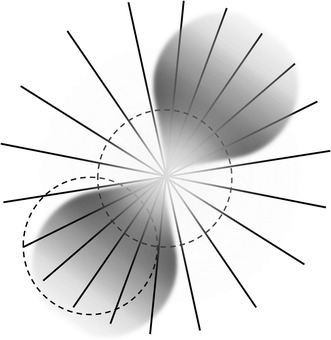Fig. 1.

The human fovea (the small area of the retina responsible for sharp central vision) surrounded by uniquely arranged nerve fibers (Henle fibers). These fibers transmit the information to the optic disc and to the brain. The Henle fibers are birefringent, causing polarization change in the reflected light. The polarization change depends on the angle between the orientation of the fiber and the plane of polarization of the incoming light. Shown is the 3° scanning circle. When the center of the fovea coincides with the center of the scanning circle, central fixation is attained and detected. In the simplest case, during central fixation, the frequency of the returning signal would be twice the scanning frequency. Note that it is the fovea that is moving, and not the scanning circle. Retinal birefringence scanning (RBS) is a technique that uses the changes in the polarization of light returning from the eye to detect the projection into space of the array of Henle fibers surrounding the fovea
